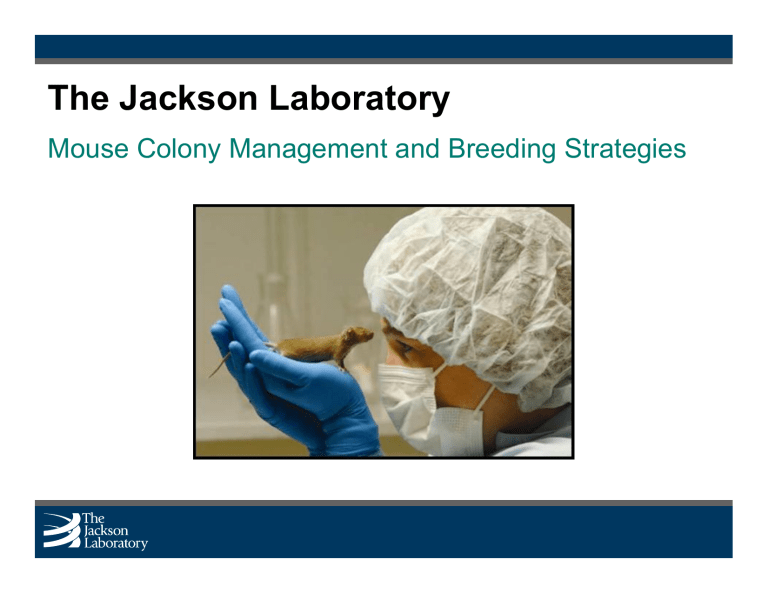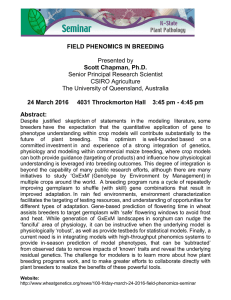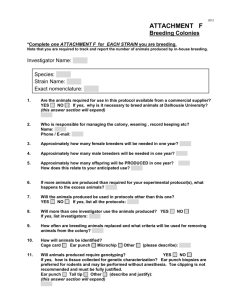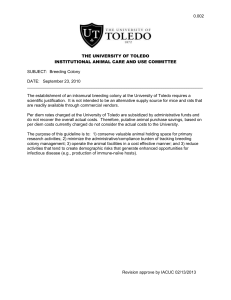
The Jackson Laboratory Mouse Colony Management and Breeding Strategies Overview • Mouse reproduction • Factors affecting breeding performance • Data collection and good colony management • Breeding schemes Mouse Reproductive Milestones • Gestation: 18.5 to 21 days • Litter size: 2 to 12+ pups • Weaning age: 17 to 28 days • Sexual maturity: 5 to 8 weeks • Productive breeding life: ~ 7-8 months Reference: Silver LM. (1995). Mouse Genetics: Concepts and Applications Oxford University Press. Online at: www.informatics.jax.org/silver/ Genetic Background Influence on Breeding Performance • • • • Hybrid vigor Fecundity Postnatal defects Behavior F1, F2 hybrids BTBR T+ tf/J C57BL/6J SJL/J Genetic Modification-Mutants and Transgenics Influence on Breeding Performance • Embryonic lethality • Infertility or subfertility • Mammary function for lactation • Abnormal behavior – poor mothering instinct – aggression • Disease – tumor development – neurodegeneration Environmental Factors Influence on Breeding Performance •Temperature •Light cycle and intensity •Noise and vibrations (construction, equipment) •Air pressure •Odors (toxic fumes, perfume) •Over handling - leave pregnant mothers alone! •New caretaker •Nutrition •Health status •Season wean / female / week Signs of Sick Mice • • • • • • • • Scruffy coat Tumors Hunched posture Weight loss Labored breathing Dermatitis, skin lesions Ocular or nasal discharge Abnormal behavior- isolation Data Collection & Record Keeping Critical for successful colony management Record Keeping: Pedigree Book Strain history – strain development – name changes Litter information – Mating pairs (dam & sire) – birth dates – litter number – number born – number weaned – animal number – sex of wean – pedigree number – genotypes (if necessary) – generation number Record Keeping- Generation Number N# = backcross generation number F# = filial (brother X sister) generation number p = cryopreserved Generation: N6F12 + F7 (N5F25p)F17 ?+ N10F5 Record Keeping Tips •Use pre-printed cards or labels •Use different colors –adjacent strains –matings vs. weanlings etc… •Separate strains with similar nomenclature •Keep cages from a single strain together –breeders and weanlings •Keep records in multiple locations •Save all cage cards Colony Management Tips • Obtain expected breeding statistics – • • Mate early- 6-12 weeks of age Replace breeders on a rotation (monthly) – • • • use inbred-specific data if mutant strain statistics not available breeding life span typically ~7- 8 months Remove non-productive breeders ASAP Collect your own breeding statistics Evaluate your data regularly Colony Management Tips (cont.) • Record and investigate deviations – – • Expect changes on a new background – • keep older generations available Choose breeders carefully – • environmental changes check genotypes (breeding errors) avoid selection pressure Keep founder stock and pedigreed colonies – filial (brother X sister) matings Pedigree Colony with Founder Stock Single Established Colony -any strain type Founder stock Producing breeders F1 F2 Line 1 Line 2 Line 3 F2 F3 F4 F2 F3 F4 F2 F3 F4 Non-Productive Breeders Criteria for Replacement • No litter produced – – • No new litters – • 60 days after first mating 90 days if slow starters 60 days from last litter No weaned pups – 2-3 litters with no wean Breeding Tips for Low Producers • • • • • • • Quiet place Ensure adequate darkness Minimal handling Use clean forceps or gloves Changing diet fat content Add nesting material Leave mating pairs together Long-Term Colony Maintenance Maintain foundation stocks to minimize the number of generations per year Replace breeders from a trusted vendor each 5 to10 generations Establish a genetic quality control plan – Genome scans- SNPs, MITs, and biochemical markers, remove spontaneous mutants Cryopreserve unique strains In June of 2001, Tropical Storm Allison battered the Houston area flooding The Texas Medical Center. While many research animals were rescued, it was estimated that 30,000 or more mice were lost. “Insurance and federal aid money should replace most of the lost material, but researchers can never get back the time they have invested. For example, some of the drowned transgenic mouse colonies at UTMSH took a decade to build, and only a minority can be regenerated from breeding pairs sent to other universities. This is a devastating loss." George Stancel, dean of the graduate school of Biomedical Science at UTMSH.” Science 22 June 2001:Vol. 292. no. 5525, p. 2226 Sperm Cryopreservation For colony “sleep” For insurance and peace of mind….development and basic phenotyping of a GM mouse can take 2-3 years and cost more than $100,000 Can you afford not to preserve? Reducing Costs • Size colony for your needs • Use both sexes in your experiments • Use an age range of mice for your experiments (e.g. 4-8 weeks of age if used monthly) • Rotate breeders on a strict schedule • Replace nonproductive breeders ASAP • Run a tight ship…. appoint a trusted colony manager to maximize your space! • Cryopreserve unique and low use strains Mouse Breeding Schemes 000642 B6.Cg-m +/+ Leprdb/J Choosing a Breeding Scheme What genotypes do I need? – most efficient way to produce them? Will appropriate controls be available? – genetic background How are genotypes identified? – phenotype? – molecular assay (e.g. PCR)? – breeding scheme? Choosing a Breeding Scheme What about Linkage? – X-linked or autosomal? – Linked or multiple genes? Reproductive issues (sterility) Phenotype issues (lethality) Homozygote (-/-) x Homozygote (-/-) 100% of offspring affected Both genders viable and fertile as homozygotes - -/-/- -/-/- Controls: – – Inbred and congenic: inbred Mixed background (e.g. C57BL/6, 129): F2 IMPORTANT! – F2 hybrid, only *approximate* control Recommendation: Outcross to appropriate F1 hybrid every 10 generations. Heterozygote (+/-) x Homozygote (-/-) 50% of offspring Homozygous One gender NOT viable / fertile as homozygote Controls: – Inbred and congenic: – + - +/-/- +/-/- inbred heterozygote siblings (if no phenotype) Mixed background (e.g. C57BL/6, 129): heterozygote siblings F2 hybrid (approximate) outcross to F1 every 10 generations Heterozygote (+/-) x Heterozygote (+/-) 25% of offspring Homozygous Neither gender viable / fertile as homozygote Controls: – Inbred and congenic: – + - + +/+ +/- +/-/- wildtype sibling heterozygote sibling (if no phenotype) Inbred Mixed background (e.g. C57BL/6, 129): wildtype or heterozygote siblings F2 hybrid (approximate) outcross to F1 every 10 generations Transgenic Mating Schemes Expression of transgene may affect viability or fertility Ex: B6.Cg-Tg(HDexon1)61Gpb/J – Huntington’s Disease model – tremors, seizures by ~ 9-11 weeks – reduced fertility (50% males infertile) – limited breeding window (3-4 weeks) Transgenic Mating Schemes Insertional mutation Ex: C57BL/6J-TgN(HBBHBG)40BCha Hmga2pg-TgN40BCha/J – Inserted into pygmy locus (Hmga2pg) – Homozygotes smaller in size; infertile Evaluate phenotype of multiple founders to determine if effects are transgene- or insertion site-specific Initial Transgenic Mating Scheme wildtype (+/+) x hemizygote (Tg/+) 50% of offspring carriers Avoid unwanted phenotypes (e.g. lethality, infertility) Controls: – Inbred and congenic – wildtype sibling Inbred Mixed background wildtype sibling + (0) + (0) Tg Tg/+ Tg/+ + (0) +/+ +/+ Complex Breeding Schemes Ex: B6C3Fe a/a-Csf1op/J Homozygous (op/op) phenotype: osteopetrosis • 1/3 smaller than unaffected siblings • Long bones shorter in length • Incisors fail to erupt; reduced viability • Bone marrow deficiencies • Reduced fertility Heterozygote (+/op) x Heterozygote (+/op) • 25% op/op • 50% op/+ • 25% +/+ Identify by phenotype Phenotype normal (breeders) Phenotype normal (controls) Could not identify het. and wt controls by PCR Complex Breeding Scheme 1 Ovarian transplant ♂ agouti ♁ op/op female Homozygous X All offspring obligate hets. X op/+ op/op ?/+ op/+ ?/+ ?/+ Usefulness of Ovarian Transplantation Circumvent genotyping difficulties / costs – B6C3Fe a/a-Csf1op/J Female infertility or reduced fertility, but gametes viable – mouse models of obesity and diabesity Extend breeding life span – Huntington’s Disease models – mouse models of ALS Complex Breeding Schemes 2 Double Mutants Ex: WB/ReJ-KitW/+ x C57BL/6J-KitW-v/+ ↓ WBB6F1/J – KitW/KitW-v Cre – lox Macrocytic anemia Mast cell deficiency Problems with infertility cre - lox Breeding Scheme loxP flanked targeted gene cre transgenic x Tissue specific “knockout” cre - lox Mechanism Floxed target gene Notable References • Linder CC. 2003. Mouse Nomenclature and Maintenance of Genetically Engineered Mice. Comp Med. 53:119-125. • Wolfer DP et al., 2002. Knockout mice: simple solutions to the problems of genetic background and flanking genes. Trends Neurosci 25(7):336-340. • Lake JP et al., 1999. Dollars and sense: Time and cost factors critical to establishing genetically engineered mouse colonies Lab Animal 28:24-33. • Silver LM. 1995. Mouse Genetics: Concepts and Applications Oxford University Press www.informatics.jax.org/silver/


